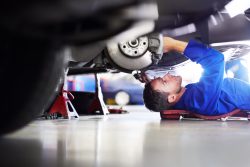4 Things Dealerships Should Keep in Mind About Absorption Rate

Chasing 100% Could Have Opposite Effect if You Lose Sight of Customers
Attaining a 100% absorption rate continues to dominate conversations in and around the automotive sector – as it has for years – but hitting the mark remains exceedingly rare. With only about 1% to 2% of dealerships nationally covering all fixed expenses with fixed operations (service, parts and body departments), many say focusing on 100% as a goal could have an adverse effect.
“There’s nothing wrong with setting your goal to a 100% absorption rate, but if your focus is only on the money (absorption), your priorities with regard to how you approach customer relationships will get distorted,” said SCL Customer Solutions Representative Don Parker, who holds over 40 years of experience in the automotive industry. “A lot of times you see dealerships chasing a 100% absorption rate and, in doing so, they’re pushing customers away. You want to run a competitive, profit-based business, but you have to keep it customer centric.”
Here are four things all automotive dealerships need to keep in mind to keep their business customer centric while chasing absorption rate goals:
-
Don’t use fear tactics on customers.
It’s important that the service department bring in sales, but trying to turn every transaction into a hard sell can turn customers away – especially when you’re using scare tactics to do it. If a customer comes in for brake pads, for example, and they’re measuring in the moderate range, instead of automotive service providers insisting they need to replace their pads that day, they should provide them with the information they need to weigh what’s best for their vehicle and their budget. “The reality is some customers can’t afford to spend hundreds of dollars on the spot, especially when they were expecting to spend one hundred,” Parker said. “But if you give them an accurate picture of what their vehicle needs, when it is needed and why, without trying to strong-arm them, they’ll return to you when they are prepared to make that purchase.”
-
Resist overloading service aisles.
When you’re focusing on service, body and parts covering all of your fixed expenses, it can be tempting to overload service aisles. The more vehicles that come through the lane, the higher the profit, right? The problem with that strategy, Parker said, is if not managed properly it could lead to long wait times and disgruntled customers. “You want to put efficient systems and processes in place, but you also want to make sure your technicians are treated well and have time to do quality work,” Parker said. “People are going to spend money to get repairs and maintenance done on their cars. If you’re scheduling properly and you can get customers in and out, offer shuttle services for longer appointments, make the waiting area welcoming, then they will spend that money with you.” In 2018, U.S. consumers spent a combined $188.5 billion on services related to the maintenance and repair of their vehicles, up from $173.5 billion in 2016, according to Statista.com. The average spend, which hovered around $849 annually per customer in 2016, has also increased.
-
Consider offering customer options for parts.
In 2018, consumers in the U.S. spent some $75 billion on vehicle parts and accessories, according to Statista, yet many dealerships and shops nationwide still believe it isn’t worth their time. According to RevolutionParts.com, using your dealership website or third-party sales sites like Amazon “open up your business to more potential customers, faster transaction rates, and higher sales volume.” Dealerships should be using their websites as business generators by optimizing for key word searches like batteries, tires, alignments, oil changes, and similar terms. “If you’re not making the parts that customers need available to them when they need them, then you’re creating a reason for them to go elsewhere. You need to find out what people need and where they’re going to get it, and turn that into a growth opportunity,” Parker said. “If I need a battery for my car, then I should be able to go who takes care of my car to get one. The same goes with tires. If you want to keep customers long-term, you have to start thinking about all of their needs.”
4. Don’t cut business development for the sake of trimming expenses.
Instead of cutting business development – which can be as small as one or two minimum-wage employees during a down turn, Parker said – dealerships should be investing in it. Having dedicated team members to call customers and remind them of upcoming needed service will increase daily appointments. Using manufacturer lists to schedule needed recall modifications will add dollars to your bottom line. Following up on no-show appointments to reschedule can also play a role in keeping service lanes full.
Business development employees can also help with service calls when the lanes are full, which can reduce stress on service advisors and keep your process efficient. They can help with tasks like mystery shopping to help create better pricing for service departments – an extremely valuable tool for instilling confidence in customers and upping satisfaction. That can also ease the burden on service advisors prone to offer discounts. According to Automotive News, knowing why your prices are what they are “makes it easier for (representatives) to believe in price structures and confidently counter price objections to customers.” In the end, that leads to greater loyalty among customers too.
Contact an SCL Consultant today
In a wide range of automotive, industrial and commercial sectors, SCL remains steadfast on its commitment to product and industry knowledge, performance satisfaction and superior logistics. We protect and optimize the machines that keep our country moving. For more information on how we help can help with services including bulk purchasing or managing inventory, contact an SCL expert today.
